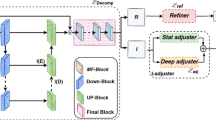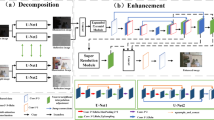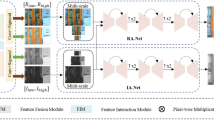Abstract
Due to the underexposure, the lack of details and the noise issues, Low-light images always have a high degree of degradation. In this paper, we thoroughly study the degradation mechanism of low-light images and design a pre-denoising 3D multi-scale fusion attention network (P3DMFE) with Retinex decomposition theory. This work is divided into three modules, firstly, The proposed three-branch decomposition module decouples the original space into three sub-spaces: reflection decomposition, illumination decomposition and noise decomposition, where the noise decomposition allows us to obtain the higher-quality reflection map and illumination map. Secondly, the 3D multi-scale fusion improvement module removes the noise map and performs image reshaping, structure restoration and detail restoration on the combined reflection map and illumination map. Thirdly, the Illumination improvement module provides a suitable illumination map. The experimental results show that the proposed P3DMFE can not only enrich the details and improve the brightness and contrast of low-light images, but also have a good denoising effect. Specifically, the proposed method can achieve 22.04 PSNR, 0.84 SSIM, 1250.4 LOE and 5.03 NIQE on LOL dataset, which are the best performance compared with some state-of-the-art methods. The experiments on common low-light datasets such as NPE, VV, MIT5K, MEF, LIME, and DICM also verify the good generalization ability and superiority of the proposed method.












Similar content being viewed by others
Explore related subjects
Discover the latest articles, news and stories from top researchers in related subjects.References
Bahdanau D, Cho K, Bengio Y (2014) Neural machine translation by jointly learning to align and translate. Preprint arXiv:1409.0473
Chen C, Chen Q, Xu J, Koltun V (2018) Learning to see in the dark. In: Proceedings of the IEEE conference on computer vision and pattern recognition, pp 3291–3300
Chen J, Lei B, Song Q, Ying H, Chen DZ, Wu J (2020) A hierarchical graph network for 3d object detection on point clouds. In: Proceedings of the IEEE/CVF conference on computer vision and pattern recognition, pp 392–401
Chrzanowski K (2013) Review of night vision technology. Opto-Electron Rev 21(2):153–181
Dong X, Wang G, Pang Y, Li W, Wen J, Meng W, Lu Y (2011) Fast efficient algorithm for enhancement of low lighting video. In: 2011 IEEE international conference on multimedia and expo, IEEE, pp 1–6
Fu J, Zheng H, Mei T (2017) Look closer to see better: recurrent attention convolutional neural network for fine-grained image recognition. In: Proceedings of the IEEE conference on computer vision and pattern recognition, pp 4438–4446
Fu X, Zeng D, Huang Y, Ding X, Zhang XP (2013) A variational framework for single low light image enhancement using bright channel prior. In: 2013 IEEE global conference on signal and information processing, IEEE, pp 1085–1088
Fu X, Zeng D, Huang Y, Liao Y, Ding X, Paisley J (2016) A fusion-based enhancing method for weakly illuminated images. Signal Process 129:82–96
Fu X, Zeng D, Huang Y, Zhang XP, Ding X (2016) A weighted variational model for simultaneous reflectance and illumination estimation. In: Proceedings of the IEEE conference on computer vision and pattern recognition, pp 2782–2790
Gao G, Xu G, Yu Y, Xie J, Yang J, Yue D (2021) Mscfnet: a lightweight network with multi-scale context fusion for real-time semantic segmentation. IEEE Trans Intell Transp Syst. https://doi.org/10.1109/TITS.2021.3098355
Gao G, Yang J, Jing XY, Shen F, Yang W, Yue D (2017) Learning robust and discriminative low-rank representations for face recognition with occlusion. Pattern Recognit 66:129–143
Gonzalez RC, Woods RE (2008) Digital image processing, prentice hall. Upper Saddle River, NJ
Guo C, Li C, Guo J, Loy CC, Hou J, Kwong S, Cong R (2020) Zero-reference deep curve estimation for low-light image enhancement. In: Proceedings of the IEEE/CVF conference on computer vision and pattern recognition, pp 1780–1789
Guo X, Li Y, Ling H (2016) Lime: low-light image enhancement via illumination map estimation. IEEE Trans Image Process 26(2):982–993
Han JH, Yang S, Lee BU (2010) A novel 3-d color histogram equalization method with uniform 1-d gray scale histogram. IEEE Trans Image Process 20(2):506–512
Hao S, Han X, Guo Y, Xu X, Wang M (2020) Low-light image enhancement with semi-decoupled decomposition. IEEE Trans Multimed 22(12):3025–3038
Hu J, Shen L, Albanie S, Sun G, Vedaldi A (2018) Gather-excite: exploiting feature context in convolutional neural networks. Preprint arXiv:1810.12348
Hu J, Shen L, Sun G (2018) Squeeze-and-excitation networks. In: Proceedings of the IEEE conference on computer vision and pattern recognition, pp 7132–7141
Huang SC, Cheng FC, Chiu YS (2012) Efficient contrast enhancement using adaptive gamma correction with weighting distribution. IEEE Trans Image Process 22(3):1032–1041
Itti L, Koch C, Niebur E (1998) A model of saliency-based visual attention for rapid scene analysis. IEEE Trans Pattern Anal Mach Intell 20(11):1254–1259
Jiang Y, Gong X, Liu D, Cheng Y, Fang C, Shen X, Yang J, Zhou P, Wang Z (2021) Enlightengan: deep light enhancement without paired supervision. IEEE Trans Image Process 30:2340–2349
Jobson DJ, Rahman ZU, Woodell GA (1997) A multiscale retinex for bridging the gap between color images and the human observation of scenes. IEEE Trans Image Process 6(7):965–976
Jobson DJ, Rahman ZU, Woodell GA (1997) Properties and performance of a center/surround retinex. IEEE Trans Image Process 6(3):451–462
Kim I, Baek W, Kim S (2020) Spatially attentive output layer for image classification. In: Proceedings of the IEEE/CVF conference on computer vision and pattern recognition, pp. 9533–9542
Li J, Fang F, Mei K, Zhang G (2018) Multi-scale residual network for image super-resolution. In: Proceedings of the European conference on computer vision (ECCV), pp 517–532
Li J, Feng X, Hua Z (2021) Low-light image enhancement via progressive-recursive network. IEEE Trans Circuits Syst Video Technol 31(11):4227–4240
Li J, Li J, Fang F, Li F, Zhang G (2021) Luminance-aware pyramid network for low-light image enhancement. IEEE Trans Multim 23:3153–3165
Li M, Liu J, Yang W, Sun X, Guo Z (2018) Structure-revealing low-light image enhancement via robust retinex model. IEEE Trans Image Process 27(6):2828–2841
Li X, Wang W, Hu X, Yang J (2019) Selective kernel networks. In: Proceedings of the IEEE/CVF conference on computer vision and pattern recognition, pp 510–519
Lim S, Kim W (2021) DSLR: Deep stacked Laplacian restorer for low-light image enhancement. IEEE Trans Multim 23:4272–4284
Long J, Shelhamer E, Darrell T (2015) Fully convolutional networks for semantic segmentation. In: Proceedings of the IEEE conference on computer vision and pattern recognition, pp 3431–3440
Lore KG, Akintayo A, Sarkar S (2017) Llnet: a deep autoencoder approach to natural low-light image enhancement. Pattern Recogn 61:650–662
Lu K, Zhang L (2021) TBEFN: A two-branch exposure-fusion network for low-light image enhancement. IEEE Trans Multim 23:4093–4105
Lv F, Lu F, Wu J, Lim C (2018) Mbllen: Low-light image/video enhancement using CNNS. In: BMVC, p 220
Ma T, Guo M, Yu Z, Chen Y, Ren X, Xi R, Li Y, Zhou X (2021) Retinexgan: unsupervised low-light enhancement with two-layer convolutional decomposition networks. IEEE Access 9:56539–56550
McCahill M (2013) The surveillance web. Willan
Mittal A, Soundararajan R, Bovik AC (2013) Making a completely blind image quality analyzer. IEEE Signal Process Lett 20(3):209–212
Mnih V, Heess N, Graves A, et al (2014) Recurrent models of visual attention. In: Advances in neural information processing systems, pp 2204–2212
Park J, Woo S, Lee JY, Kweon IS (2018) Bam: bottleneck attention module. Preprint arXiv:1807.06514
Pisano ED, Zong S, Hemminger BM, DeLuca M, Johnston RE, Muller K, Braeuning MP, Pizer SM (1998) Contrast limited adaptive histogram equalization image processing to improve the detection of simulated spiculations in dense mammograms. J Digit Imaging 11(4):193
Ren X, Li M, Cheng WH, Liu J (2018) Joint enhancement and denoising method via sequential decomposition. In: 2018 IEEE international symposium on circuits and systems (ISCAS), IEEE, pp 1–5
Ronneberger O, Fischer P, Brox T (2015) U-net: Convolutional networks for biomedical image segmentation. In: International conference on medical image computing and computer-assisted intervention, . Springer, pp 234–241
Roy AG, Navab N, Wachinger C (2018) Concurrent spatial and channel ‘squeeze & excitation’ in fully convolutional networks. In: International conference on medical image computing and computer-assisted intervention, Springer, pp 421–429
Shen L, Yue Z, Feng F, Chen Q, Liu S, Ma J (2017) Msr-net: low-light image enhancement using deep convolutional network. Preprint arXiv:1711.02488
Wang F, Jiang M, Qian C, Yang S, Li C, Zhang H, Wang X, Tang X (2017) Residual attention network for image classification. In: Proceedings of the IEEE conference on computer vision and pattern recognition, pp 3156–3164
Wang R, Zhang Q, Fu CW, Shen X, Zheng WS, Jia J (2019) Underexposed photo enhancement using deep illumination estimation. In: Proceedings of the IEEE/CVF conference on computer vision and pattern recognition, pp 6849–6857
Wang S, Zheng J, Hu HM, Li B (2013) Naturalness preserved enhancement algorithm for non-uniform illumination images. IEEE Trans Image Process 22(9):3538–3548
Wang W, Ng MK (2013) A variational histogram equalization method for image contrast enhancement. SIAM J Imag Sci 6(3):1823–1849
Wang W, Wei C, Yang W, Liu J (2018) Gladnet: Low-light enhancement network with global awareness. In: 2018 13th IEEE international conference on automatic face & gesture recognition (FG 2018), IEEE, pp 751–755
Wei C, Wang W, Yang W, Liu J (2018) Deep retinex decomposition for low-light enhancement. Preprint arXiv:1808.04560
Xu H, Zhai G, Wu X, Yang X (2013) Generalized equalization model for image enhancement. IEEE Trans Multim 16(1):68–82
Xu K, Ba J, Kiros R, Cho K, Courville A, Salakhudinov R, Zemel R, Bengio Y (2015) Show, attend and tell: Neural image caption generation with visual attention. In: International conference on machine learning, PMLR, pp 2048–2057
Xu K, Yang X, Yin B, Lau RW (2020) Learning to restore low-light images via decomposition-and-enhancement. In: Proceedings of the IEEE/CVF conference on computer vision and pattern recognition, pp 2281–2290
Yang W, Wang S, Fang Y, Wang Y, Liu J (2020) From fidelity to perceptual quality: a semi-supervised approach for low-light image enhancement. In: Proceedings of the IEEE/CVF conference on computer vision and pattern recognition, pp 3063–3072
Ying Z, Li G, Gao W A (2017) bio-inspired multi-exposure fusion framework for low-light image enhancement. Preprint arXiv:1711.00591
Ying Z, Li G, Ren Y, Wang R, Wang W (2017) A new low-light image enhancement algorithm using camera response model. In: Proceedings of the IEEE international conference on computer vision workshops, pp 3015–3022
Yurtsever E, Lambert J, Carballo A, Takeda K (2020) A survey of autonomous driving: common practices and emerging technologies. IEEE access 8:58443–58469
Zhang L, Zhang L, Liu X, Shen Y, Zhang S, Zhao S (2019) Zero-shot restoration of back-lit images using deep internal learning. In: Proceedings of the 27th ACM international conference on multimedia, pp 1623–1631
Zhang Y, Zhang J, Guo X (2019) Kindling the darkness: a practical low-light image enhancer. In: Proceedings of the 27th ACM international conference on multimedia, pp 1632–1640
Zhu G, Ma L, Liu R, Fan X, Luo Z (2021) Collaborative reflectance-and-illumination learning for high-efficient low-light image enhancement. In: 2021 IEEE international conference on multimedia and expo (ICME), IEEE, pp 1–6
Acknowledgements
This study was funded by the Natural Science Foundation of Liaoning Province (No. 2020–MS–080), the National Natural Science Foundation of China (No. 61772125)
Author information
Authors and Affiliations
Corresponding author
Ethics declarations
Conflict of interest
The authors declare that they have no conflict of interest.
Additional information
Publisher's Note
Springer Nature remains neutral with regard to jurisdictional claims in published maps and institutional affiliations.
Rights and permissions
Springer Nature or its licensor (e.g. a society or other partner) holds exclusive rights to this article under a publishing agreement with the author(s) or other rightsholder(s); author self-archiving of the accepted manuscript version of this article is solely governed by the terms of such publishing agreement and applicable law.
About this article
Cite this article
Zhu, H., Zhang, Z., Wang, L. et al. Pre-denoising 3D Multi-scale Fusion Attention Network for Low-Light Enhancement. Neural Process Lett 55, 5717–5743 (2023). https://doi.org/10.1007/s11063-022-11107-x
Accepted:
Published:
Issue Date:
DOI: https://doi.org/10.1007/s11063-022-11107-x




